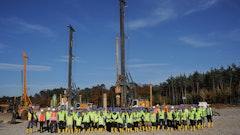Despite admitting he's sometimes labeled "Dr. Doom," Ed Sullivan, vice president and chief economist for the Portland Cement Association (PCA), had some positive things to say about the construction economy – with caveats – while addressing attendees of the Associated Equipment Distributors Executive Forum, September 6-7 in Rosemont, IL. He started by indicating that construction activity has grown 5.8% during the first half of 2012.
"If we hold on that track, it will be the first time in four years construction has posted real gain," he said. The gain was led by a 14.4% bump in nonresidential and an 8.4% rise in residential construction compared to 2011. Conversely, public construction slid by 7.1%.
Improvements in residential and nonresidential activity were achieved despite sluggish U.S. economic growth and limited job creation. But Sullivan cautioned that any growth stems from extremely low levels.
"Our industry declined 54% since 2009," he pointed out. He anticipates flat to modest growth in 2013, with potential double-digit gains starting in 2014 and continuing through at least 2017. However, several years of sustained increases will be required for the industry to even approach pre-recessionary levels.
Cliff Looms Large in Outlook
The elephant in the room throughout the Executive Forum was the looming "fiscal cliff" the U.S. economy is currently facing. Approximately $400 billion in tax increases, stemming from expiration of the Tax Relief, Unemployment Insurance Reauthorization, and Job Creation Act of 2010, and $200 billion in spending reductions under the Budget Control Act of 2011 are scheduled to go into effect beginning January 2.
"It was thought that in two years, the economy would get strong enough to handle the spending cuts and tax increases," Sullivan commented. Unfortunately, this is not the case. "The economy didn't gain as much strength as expected, and Congress has failed to reach an agreement. Now we are left at the mercy of this law, which will go into effect unless Congress acts.
"Given the current fragility of the economy, many believe that the fiscal policy could push the economy into another recession," he added.
The roughly $600 billion represented by the fiscal cliff is equivalent to roughly 4% of U.S. GDP. With the U.S. economy expected to continue growing at less than 3%, this would push the GDP back into negative, or recessionary, territory. Such a crisis can be averted only if Congress can agree on legislation to prevent the tax increases and spending cuts from going into effect.
"The outlook on the economy depends on how Congress acts," said Sullivan. "We don't know if Congress has the will to make these decisions."
Sullivan foresees three scenarios. The first is a "rational" Congress that addresses the issue and acts before the end of the year. The second is a "dysfunctional" Congress that waits until the economy takes the fiscal leap, then steps in. But by then, it may be too late.
"Once you let the genie out of the bottle, it's difficult to put it back in," Sullivan commented. "Adverse momentum will kick in and it will be difficult to turn around. You're left with a very tepid [economic] recovery into the second part of next year – 0% growth, maybe slightly negative."
The third scenario is a Congress incapable of reaching an agreement. "If you have a complete Congressional impasse, it's a severe recession scenario," Sullivan predicted.
Already, the U.S. economy is seeing a slowdown as the fiscal cliff begins to loom. Consumer sentiment is at its lowest recorded level since 2009. Economic growth in the second half of 2012 is crawling forward, with job creation and construction activity keeping pace. "Inaction of Congress so far may already be impacting economic performance in 2012 because it creates uncertainty," said Sullivan. "As the risks of recession rise, consumer sentiment declines and economic growth declines with it."
Moving Forward
Despite the potentially gloomy prospects, the PCA is working under the assumption that the fiscal cliff will be averted. "Our expectation is they will deal with it, but the economy will be slow to come back," Sullivan said.
Currently, the PCA is forecasting construction spending for 2012 to close out at 5.5%, decline slightly to 5.0% in 2013, then jump to 9.5% in 2014, as the structural issues (foreclosures, high vacancy rates, state budgets) begin to heal and pent-up demand kicks in for all three market sectors – housing, commercial and public construction. By 2014, Sullivan predicts all three sectors will be back in positive territory, and double-digit gains in construction could once again start to materialize.
















